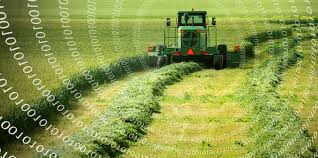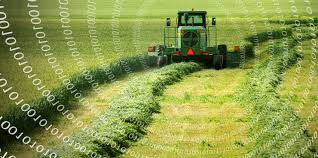
The ability of Monsanto, which has become a leading provider of analytics used by growers, to provide and offer the growth in digitally assisted farming was the key reason that German chemical company Bayer made the $62 billion bid for the US seed giant.
Monsanto is at the “forefront of digital farming”, says Bayer Chief Executive Officer Werner Baumann. Bayer’s goal of identifying and providing the best-suited seeds, fertilizers, and chemicals for farms around the world would be furthered by the acquisition of the company.
“If you get the customers’ attention by predicting what will happen on their farm, you can be closer to them to sell them the seeds and whatever other products you want to sell them,” says Bruce Erickson, a director in the agronomy department at Purdue University who tracks farming technology.
“The promise is immense,” he said.
Sensor- laden tractors monitoring harvests in real time, drones providing bird’s-eye views of fields and mapping software locating underground water sources are just some of the signs of the transformation which abound in number and applications.
In examples where digital advancement is helping outside the fields also include infrared cameras identify chickens with fevers, protecting flocks and cows’ meal portions are adjusted automatically based on their milk output.
There are concerns that food production isn’t keeping up with the world’s appetite and the adoption of digital tools comes amid such concerns. Even as demand is increasing because of population growth and the rising middle class in developing nations such as China, crop yields have remained relatively flat in recent years.
Investment is pouring into digital farming as investors sense an opportunity. According to AgFunder, an online investing platform, compared with $2.3 billion in 2014, food and agriculture technology startups attracted $4.6 billion last year.
Monsanto invested $1 billion for San Francisco-based startup Climate Corp in 2013 which marked the company’s take off in investments in digital agriculture. Climate Corp. developed an algorithm that helps predict how weather affects crop output and was founded by former Google engineers David Friedberg and Siraj Khaliq. Monsanto acquired soil and analytics companies and added its own data from seed trials. Now recommendations on what to plant and where to plant it are made to farmers by its software.
“Farmers are very excited about new technology if you can show them some value, that it’s not just some gimmick. We can take our data, walk right into the fields with an iPad or iPhone, pinpoint exactly where we are ... and figure out what we should be doing with each parcel of land,” says Khaliq, who’s now a venture capitalist in London.
Blue River Technology, a California company that uses computer vision technology to weed crops, was also invested in by Monsanto. VitalFields, a maker of farm management software and HydroBio, which produces tools that monitor water usage, were also backed by it. Meanwhile, data company Farmers Business Network raised $15 million from investors including Google parent Alphabet and Planet Labs, whose satellite monitoring technology tracks changes in crops and soils, raised $120 million last year.
Central U.S., where industrial farms put a premium on efficiency, has seen the fasted adoption of digital agriculture.
“We can take our data, walk right into the fields with an iPad or iPhone, pinpoint exactly where we are in the field, and see what the planting rate is, what the amount of nitrogen is, and figure out what we should be doing with each parcel of land,” says Dale Hadden of central Illinois who has been collecting data to improve the performance of the soybeans, corn, and wheat he grows on his almost 5,000 acres.
Tapping into global communications networks may allow farmers to better manage climate change and other risks in the developing world by bringing Big Data to the world’s most information-poor regions presents the greatest potential for digital agriculture.
“We’re starting to see the emergence of a digital revolution. It’s moving from decisions based on a farmer’s skill to decisions based on objective information driven from technologies now available,” says Mick Keogh, the executive director of the Australian Farm Institute.
(Source:www.reuters.com)
Monsanto is at the “forefront of digital farming”, says Bayer Chief Executive Officer Werner Baumann. Bayer’s goal of identifying and providing the best-suited seeds, fertilizers, and chemicals for farms around the world would be furthered by the acquisition of the company.
“If you get the customers’ attention by predicting what will happen on their farm, you can be closer to them to sell them the seeds and whatever other products you want to sell them,” says Bruce Erickson, a director in the agronomy department at Purdue University who tracks farming technology.
“The promise is immense,” he said.
Sensor- laden tractors monitoring harvests in real time, drones providing bird’s-eye views of fields and mapping software locating underground water sources are just some of the signs of the transformation which abound in number and applications.
In examples where digital advancement is helping outside the fields also include infrared cameras identify chickens with fevers, protecting flocks and cows’ meal portions are adjusted automatically based on their milk output.
There are concerns that food production isn’t keeping up with the world’s appetite and the adoption of digital tools comes amid such concerns. Even as demand is increasing because of population growth and the rising middle class in developing nations such as China, crop yields have remained relatively flat in recent years.
Investment is pouring into digital farming as investors sense an opportunity. According to AgFunder, an online investing platform, compared with $2.3 billion in 2014, food and agriculture technology startups attracted $4.6 billion last year.
Monsanto invested $1 billion for San Francisco-based startup Climate Corp in 2013 which marked the company’s take off in investments in digital agriculture. Climate Corp. developed an algorithm that helps predict how weather affects crop output and was founded by former Google engineers David Friedberg and Siraj Khaliq. Monsanto acquired soil and analytics companies and added its own data from seed trials. Now recommendations on what to plant and where to plant it are made to farmers by its software.
“Farmers are very excited about new technology if you can show them some value, that it’s not just some gimmick. We can take our data, walk right into the fields with an iPad or iPhone, pinpoint exactly where we are ... and figure out what we should be doing with each parcel of land,” says Khaliq, who’s now a venture capitalist in London.
Blue River Technology, a California company that uses computer vision technology to weed crops, was also invested in by Monsanto. VitalFields, a maker of farm management software and HydroBio, which produces tools that monitor water usage, were also backed by it. Meanwhile, data company Farmers Business Network raised $15 million from investors including Google parent Alphabet and Planet Labs, whose satellite monitoring technology tracks changes in crops and soils, raised $120 million last year.
Central U.S., where industrial farms put a premium on efficiency, has seen the fasted adoption of digital agriculture.
“We can take our data, walk right into the fields with an iPad or iPhone, pinpoint exactly where we are in the field, and see what the planting rate is, what the amount of nitrogen is, and figure out what we should be doing with each parcel of land,” says Dale Hadden of central Illinois who has been collecting data to improve the performance of the soybeans, corn, and wheat he grows on his almost 5,000 acres.
Tapping into global communications networks may allow farmers to better manage climate change and other risks in the developing world by bringing Big Data to the world’s most information-poor regions presents the greatest potential for digital agriculture.
“We’re starting to see the emergence of a digital revolution. It’s moving from decisions based on a farmer’s skill to decisions based on objective information driven from technologies now available,” says Mick Keogh, the executive director of the Australian Farm Institute.
(Source:www.reuters.com)





